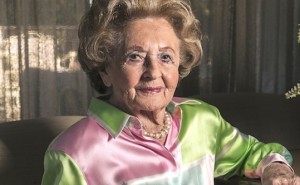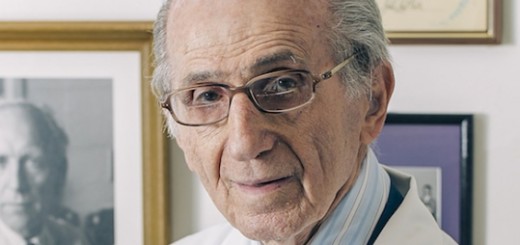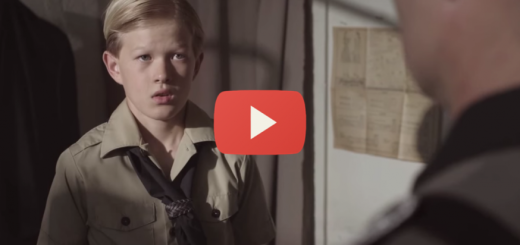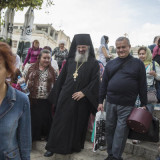SURVIVOR: LIDIA BUDGOR
 The cattle car pulled up to the Auschwitz platform. As the doors opened, German soldiers with guns and barking dogs began pushing out the more than 100 Jews arriving from the Lodz Ghetto. “Raus, raus,” they shouted, “Out, out.” Lidia Budgor — then Lola Gryngras — fell and cut her lip as she exited, but she kept walking. Her two younger brothers were sent with the men. She continued with her mother, two younger sisters and two aunts. As they neared the gate, Lidia’s brother Chaim ran up to them, planted a kiss on his mother’s cheek and ran back to the men’s section. Minutes later, Lidia’s mother and two sisters were directed to the left and Lidia and her two aunts to the right. “Everybody right away was sent to the gas chamber,” Lidia recalled. It was August 1944. Lidia was 19.
The cattle car pulled up to the Auschwitz platform. As the doors opened, German soldiers with guns and barking dogs began pushing out the more than 100 Jews arriving from the Lodz Ghetto. “Raus, raus,” they shouted, “Out, out.” Lidia Budgor — then Lola Gryngras — fell and cut her lip as she exited, but she kept walking. Her two younger brothers were sent with the men. She continued with her mother, two younger sisters and two aunts. As they neared the gate, Lidia’s brother Chaim ran up to them, planted a kiss on his mother’s cheek and ran back to the men’s section. Minutes later, Lidia’s mother and two sisters were directed to the left and Lidia and her two aunts to the right. “Everybody right away was sent to the gas chamber,” Lidia recalled. It was August 1944. Lidia was 19.
Lidia was born on Aug. 23, 1925, in Lodz, Poland, to parents Berl and Mariem Gryngras. She was the oldest of five siblings.
The family was Chasidic and lived in one large room with a small kitchen. The two aunts, Lidia’s mother’s younger sisters, lived with them. Lidia’s father had a successful business selling silk threads and fabrics.
Lidia attended Jewish school until age 14. Her father also hired tutors to augment the children’s Jewish studies.
In early September 1939, Lidia’s mother and siblings were vacationing at their summer cottage near Lask, Poland, while Lidia was home preparing for school. One day her father unexpectedly returned from work around noontime. “Daughter, the war broke out,” he announced. He left to fetch Lidia’s mother and siblings.
“That was the end of normalcy,” Lidia said.
Almost immediately Lidia’s father could no longer go outdoors for fear of having his beard cut off or being beaten up. Plus, the Nazis had confiscated everything in his office. He had only some pieces of fabric and thread at home.
During the day, Lidia’s mother tried to sell fabric or thread. Lidia, who was blond and “looked like a little Polish girl,” stood in long lines to buy bread with whatever money they had.
In early February 1940, the Germans established a ghetto in Lodz, and the family of nine moved into one room. But Lidia, who had a job assigning ghetto apartments, found her family a bigger room with a kitchen. Lidia also befriended the Jewish police, gaining “protectzia” for her family.
Lidia then worked in the ghetto’s meat distribution center, cutting ration coupons. Sometimes she managed to procure a piece of meat or a horse bone to bring home for soup. She also smuggled home horse fat in her armpit.
One day in spring 1944, however, Lidia was denounced by another Jew for stealing a bucket of horse guts. She was fired from her job and given a new job pulling wagons filled with human excrement.
Lidia complained to ghetto commissioner Aron Jakubowicz at the Central Office of Labor Workshops. He dismissed the new job assignment and gave her a loaf of bread. “I had a lot of chutzpah,” she recalled.
For a long time, Lidia and her family were shielded from deportations. But in August 1944, as the ghetto was being liquidated, the family was taken to a prison on Czarnieckiego Street that also served as a transit station to the death camps. “We knew about Auschwitz. We knew even about the gas chambers,” Lidia said.
One day Lidia glanced across the barbed-wire fence at the men’s quarters and saw her father with a group of men sitting on the ground, all with their hands atop their heads. It was her last look at her father, who was transported to Auschwitz. Soon after, Lidia, her mother, siblings and two aunts were shipped there.
Ten days after arriving at Auschwitz, Lidia was sent by open train car to Stutthof Concentration Camp, 34 kilometers east of Gdansk, Poland. She was given a job cutting bread. She worked and slept in the back of a women’s barracks, where a big table with a cutting machine was stationed in front of a window.
One day an ill-looking girl wrapped in a ragged black blanket walked under the window. Lidia pushed out some breadcrumbs, which the girl caught in her blanket. She came back every day, and Lidia continued to give her crumbs and pieces of bread. “I saved her life,” she said.
A couple of months later, Lidia contracted typhus and was thrown back into the barracks where she was very sick.
Soon after, with the Russian army approaching, the Germans sent Lidia and other prisoners on a death march toward the Baltic Sea. It was January 1945, a bitterly cold winter, and Lidia had a blanket full of lice, broken wooden clogs and a high fever. While walking one day, a girl in a white raincoat brought her some bread. Lidia recognized her as the girl in the black blanket. The girl also filled Lidia’s tin cup with snow several times a day, to help lower her fever. Lidia named her “the white angel.”
After six weeks, those who survived the march — about 1,000, Lidia estimates — were taken to a barn on an estate in Kolki, Pomerania. It was cold and miserable.
“The white angel,” whose name was Mary, was assigned to the kitchen. She brought Lidia with her, giving her a hot bath and food.
In March, hearing that the Russians were coming, Lidia and Mary, along with two other girls, hid in a pigsty on the estate. A few days later, they heard tanks rumbling by and saw German prison guards running into the woods. It was March 10; they had been liberated.
When Lidia walked out of the pigsty, she thought, “I’m free.” Then she wondered, “What for?” She knew she had no family.
A few weeks later, Lidia and the other girls were living in a beautiful house that had belonged to Germans in Słupsk, Pomerania.
A Lithuanian Jew, also a former inmate at Stutthof, brought meat to the girls’ house. His name was Wolf Budgor, and he had his eye on Lidia. The attraction was reciprocal, and the two married at the end of 1945.
One evening, members of the Haganah, a Jewish military organization, knocked on the door. The Russians were coming for Wolf and Lidia, and the Haganah members smuggled them to Vienna.
Lidia and Wolf arrived at the Bindermichl displaced persons camp in Vienna in winter 1946. About a year later, they moved to the Wegscheide displaced persons camp near Munich. Their son, Aaron, was born there on July 6, 1948.
Finally, in 1952 they received a visa to the United States, moving to Dallas. In 1956 they relocated to Vineland, N.J., and in 1959 they moved to Los Angeles.
In 1960, Lidia opened her own retail clothing store, called Lidia’s, in West Los Angeles. She closed the business in 2008.
Lidia was a founding member of the Los Angeles Museum of the Holocaust. She also established the Lodzer Organization for survivors from Lodz and was a frequent speaker at schools and synagogues.
Wolf died on Jan. 1, 2000. Their son is married with two grown children.
Today Lidia is 87, serves on the board of the Los Angeles Museum of the Holocaust and is an active member of Jewish Family Service’s Café Europa.
“I always had this indestructible spirit. I had chutzpah, and I tried in every shape and form to save my family,” Lidia said.











Major thanks for the post. Fantastic.